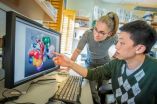(Press-News.org) An international team including Lawrence Livermore National Laboratory scientists has definitively measured the spin rate of a supermassive black hole for the first time.
The findings, made by the two X-ray space observatories, NASA's Nuclear Spectroscopic Telescope Array (NuSTAR) and the European Space Agency's XMM-Newton, solve a long-standing debate about similar measurements in other black holes and will lead to a better understanding of how black holes and galaxies evolve.
"We can trace matter as it swirls into a black hole using X-rays emitted from regions very close to the black hole," said Fiona Harrison, NuSTAR principal investigator at the California Institute of Technology, Pasadena, and coauthor of a new study appearing in the Feb. 28 edition of Nature. "The radiation we see is warped and distorted by the motions of particles, and by the black hole's incredibly strong gravity."
The formation of supermassive black holes is thought to mirror the formation of the galaxy itself, since a fraction of all the matter drawn into the galaxy finds its way into the black hole. Because of this, astronomers are interested in measuring the spin rates of black holes in the hearts of galaxies.
The observations also are a powerful test of Einstein's theory of general relativity, which holds that gravity can bend light and space-time. The X-ray telescopes detected these warping effects in the most extreme of environments, where the immense gravity field of a black hole is severely altering space-time.
NuSTAR, a NASA Explorer-class mission launched in June of 2012, is uniquely designed to detect the highest-energy X-ray light in great detail. For Livermore, the predecessor to NuSTAR was a balloon-borne instrument known as HEFT (the High Energy Focusing Telescope) that was funded, in part, by a Laboratory Directed Research and Development investment beginning in 2001. NuSTAR takes HEFT's X-ray focusing abilities and sends them beyond Earth's atmosphere on a satellite. The optics design and the manufacturing process for NuSTAR are based on those used to build the HEFT telescopes.
NuSTAR complements telescopes that observe lower-energy X-ray light, such as the European Space Agency's (ESA's) XMM-Newton and NASA's Chandra X-ray Observatory. Scientists use these and other telescopes to estimate the rates at which black holes spin.
"We know that black holes have a strong link to their host galaxy," said astrophysicist Bill Craig, a member of the LLNL team. "Measuring the spin, one of the few things we can directly measure from a black hole, will give us clues to understanding this fundamental relationship."
The team used NuSTAR to observe X-rays emitted by hot gas in a disc just outside the "event horizon," the boundary surrounding a black hole beyond which nothing, including light, can escape.
Previous measurements were uncertain because obscuring clouds around the black holes could, in theory, have been confusing the results. By working together with XMM-Newton, NuSTAR was able to see a broader range of X-ray energy, penetrating deeper into the region around the black hole. The new observations ruled out the idea of obscuring clouds, demonstrating that spin rates of supermassive black holes can be determined conclusively.
"This is hugely important to the field of black hole science," said Lou Kaluzienski, NuSTAR program scientist at NASA Headquarters in Washington, D.C. "NASA and ESA telescopes tackled this problem together. In tandem with the lower-energy X-ray observations carried out with XMM-Newton, NuSTAR's unprecedented capabilities for measuring the higher energy X-rays provided an essential, missing puzzle piece for unraveling this problem."
NuSTAR and XMM-Newton simultaneously observed the two-million-solar-mass supermassive black hole lying at the dust and gas-filled heart of a galaxy called NGC 1365. The results showed that the black hole is spinning close to the maximal rate allowed by Einstein's theory of gravity.
"These monsters, with masses from millions to billions of times that of the sun, are formed as small seeds in the early universe and then grow by swallowing stars and gas in their host galaxies, and/or merging with other giant black holes when galaxies collide," said Guido Risaliti, lead author of the new study from the Harvard-Smithsonian Center for Astrophysics in Cambridge, Mass. and the Italian National Institute for Astrophysics. "Measuring the spin of a supermassive black hole is fundamental to understanding its past history and that of its host galaxy."
###
Founded in 1952, Lawrence Livermore National Laboratory provides solutions to our nation's most important national security challenges through innovative science, engineering and technology. Lawrence Livermore National Laboratory is managed by Lawrence Livermore National Security, LLC for the U.S. Department of Energy's National Nuclear Security Administration.
NuSTAR helps solve riddle of black hole spin
2013-02-28
ELSE PRESS RELEASES FROM THIS DATE:
First grade math skills set foundation for later math ability
2013-02-28
Children who failed to acquire a basic math skill in first grade scored far behind their peers by seventh grade on a test of the mathematical abilities needed to function in adult life, according to researchers supported by the National Institutes of Health.
The basic math skill, number system knowledge, is the ability to relate a quantity to the numerical symbol that represents it, and to manipulate quantities and make calculations. This skill is the basis for all other mathematics abilities, including those necessary for functioning as an adult member of society, a ...
A game plan for climate change
2013-02-28
Researchers have successfully piloted a process that enables natural resource managers to take action to conserve particular wildlife, plants and ecosystems as climate changes.
The Adaptation for Conservation Targets (ACT) framework is a practical approach to assessing how future changes in air and water temperatures, precipitation, stream flows, snowpack, and other environmental conditions might affect natural resources. ACT enables scientists and managers to work hand-in-hand to consider how management actions may need to be adjusted to address those impacts.
"As ...
Changing shape makes chemotherapy drugs better at targeting cancer cells
2013-02-28
(Santa Barbara, Calif. –) Bioengineering researchers at University of California, Santa Barbara have found that changing the shape of chemotherapy drug nanoparticles from spherical to rod-shaped made them up to 10,000 times more effective at specifically targeting and delivering anti-cancer drugs to breast cancer cells.
Their findings could have a game-changing impact on the effectiveness of anti-cancer therapies and reducing the side effects of chemotherapy, according to the researchers. Results of their study were published recently in Proceedings of the National Academy ...
Retailers should re-size maternity wear for women throughout their pregnancies, MU study finds
2013-02-28
COLUMBIA, Mo. — Fashion retailers have seen an increase in demand for maternity wear in recent years, as sales for maternity clothing have increased while overall women's apparel sales have declined. Currently, most retailers produce maternity wear using a standardized size chart that begins with women in their seventh month of pregnancy. Retailers produce garments for women who are earlier in their terms by adjusting the sizes smaller proportionally based on the standardized chart. In a recent study, University of Missouri researcher MyungHee Sohn, an assistant professor ...
Reading the human genome
2013-02-28
Researchers with the U.S. Department of Energy (DOE)'s Lawrence Berkeley National Laboratory (Berkeley Lab) have achieved a major advance in understanding how genetic information is transcribed from DNA to RNA by providing the first step-by-step look at the biomolecular machinery that reads the human genome.
"We've provided a series of snapshots that shows how the genome is read one gene at a time," says biophysicist Eva Nogales who led this research. "For the genetic code to be transcribed into messenger RNA, the DNA double helix has to be opened and the strand of gene ...
Workstation design improvements for drone operators may reduce costs & mishaps, researchers suggest
2013-02-28
The U.S. Department of Defense reports that drone accidents in which personnel or aircraft are damaged or destroyed occur 50 times more often than mishaps involving human-operated aircraft. The U.S. Marines and Army reported 43 mishaps that involved human factors issues associated with drone ground control workstations and technology during 2006−2007.
Human factors/ergonomics (HF/E) researchers Qaisar Waraich, Thomas Mazzuchi, Shahram Sarkani, and David F. Rico suggest that multimillion-dollar drone losses might be prevented if long-established and broadly applied ...
Protein balance key in preventing cancer
2013-02-28
PHILADELPHIA, PA (February 27, 2013)—Two proteins that scientists once thought carried out the same functions are actually antagonists of each other, and keeping them in balance is key to preventing diseases such as cancer, according to new findings published in the February 25 issue of Developmental Cell by scientists at Fox Chase Cancer Center. The results suggest that new compounds could fight cancer by targeting the pathways responsible for maintaining the proper balance between the proteins.
"It's our job now to understand how we can intervene therapeutically in ...
NASA's Aquarius sees salty shifts
2013-02-28
The colorful images chronicle the seasonal stirrings of our salty world: Pulses of freshwater gush from the Amazon River's mouth; an invisible seam divides the salty Arabian Sea from the fresher waters of the Bay of Bengal; a large patch of freshwater appears in the eastern tropical Pacific in the winter. These and other changes in ocean salinity patterns are revealed by the first full year of surface salinity data captured by NASA's Aquarius instrument.
"With a bit more than a year of data, we are seeing some surprising patterns, especially in the tropics," said Aquarius ...
GSA Today: Putting time in its place
2013-02-28
Boulder, Colorado, USA – In the March issue of GSA Today, seven scientists from six countries, led by Jan Zalasiewicz of the University of Leicester, propose a realignment of the terms "geochronology" and "chronostratigraphy" in an attempt to resolve the debate of whether units of the Geological Time Scale should have a single (time) or dual (time and time-rock) hierarchy.
In their system, which retains both parallel sets of units, with an option to adopt one or other when appropriate, geochronology refers to all methods of numerical dating and is used to express the ...
Fermi's motion produces a study in spirograph
2013-02-28
VIDEO:
The Vela pulsar outlines a fascinating pattern in this movie showing 51 months of position and exposure data from Fermi's Large Area Telescope (LAT). The pattern reflects numerous motions of...
Click here for more information.
NASA's Fermi Gamma-ray Space Telescope orbits our planet every 95 minutes, building up increasingly deeper views of the universe with every circuit. Its wide-eyed Large Area Telescope (LAT) sweeps across the entire sky every three hours, capturing ...




